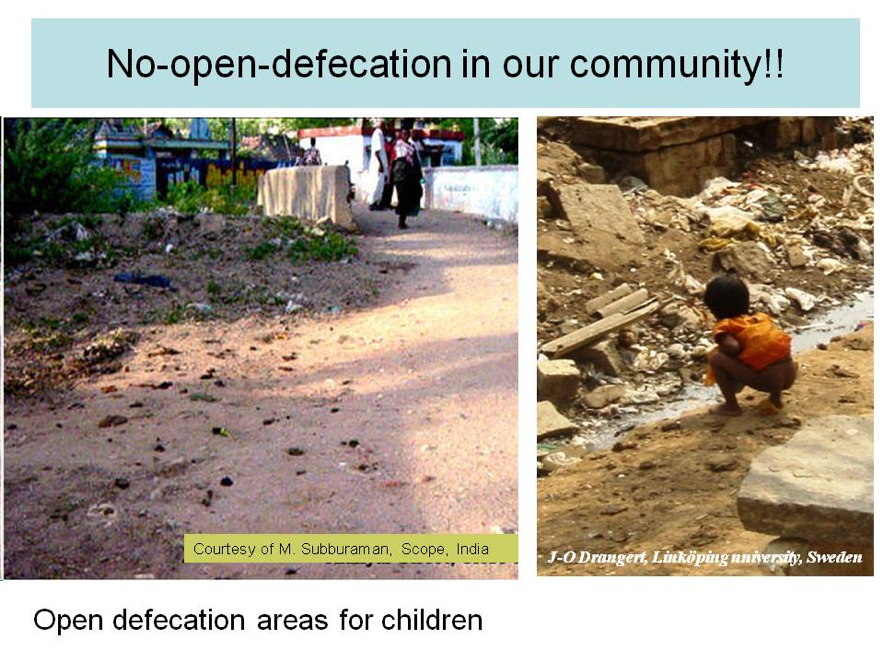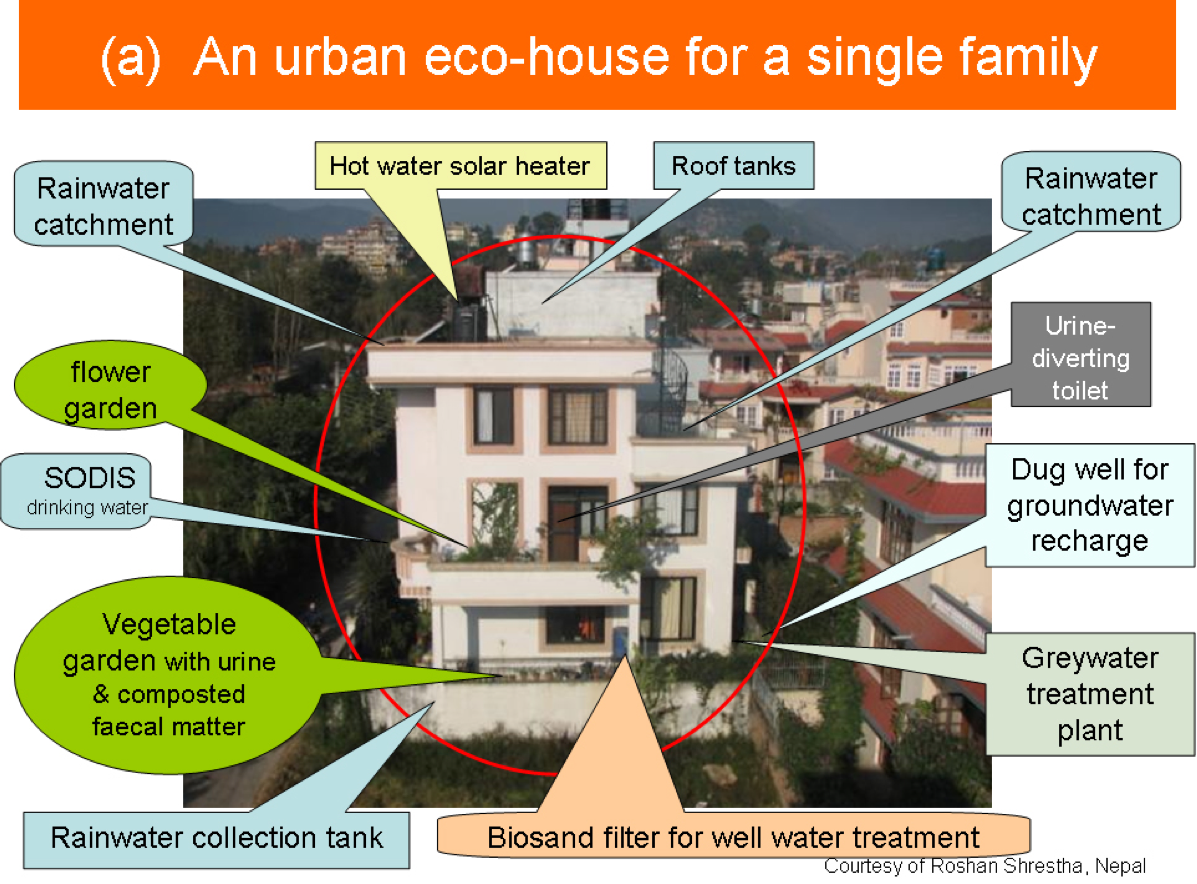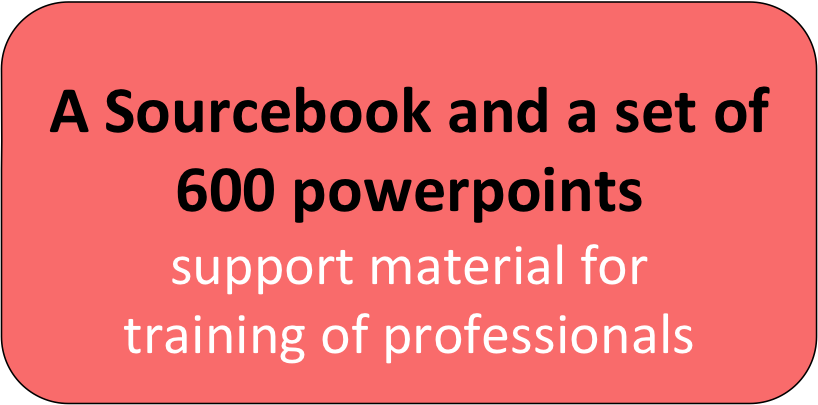Sustainable sanitation training material

Sustainable Sanitation for the 21st Century
A sourcebook for training is now available for free download
This sourcebook is the result of experiences gained over the last decade from more than 300 participants attending an international training course and ongoing research.
Sustainable Sanitation aims at protecting human and environmental health through safe use and reuse of available resources
Both Sourcebook and set of 600 animated PowerPoints provide the knowledge and skills required to address the five improvements below.
- There is no water scarcity in cities, only poor management of the available water.
- Morbidity can be reduced through washing hands and safe handling of child faeces.
- Future toxic shocks can be avoided through harnessing our chemical society by source control of products.
- Food security can be achieved through reduced wastage, recycling of nutrients and changes in diets.
- Households and residents hold the key to improvements mainly through improved sanitation routines, and also through exercising the power as consumers and voters.
The material is multi-disciplinary and covers management issues, town planning, civil and environmental engineering, public health, urban agriculture, etc.
- You can access information and useful references from the Sourcebook (700 pages in pdf format)
- You can combine your own training material with the PowerPoints you pick out of this set of 600 slides. Below are two examples:
Downloads
| Introduction: ppt - 0.7 MB, pdf - 2.4 MB |
Chapter 1 - Sustainable sanitation - a review
| Questions | Learning objectives | Download | |
| Module 1.1 Sanitary conditions in the world |
What functions should a sustainable system fulfill? Is sanitation in the world improving or not? | Sanitary conditions in various parts of the world. Critical understanding of data and functions. | ppt 2.3 MB pdf 2.5 MB |
| Module 1.2 Resources |
Where are the resources? What might be the problem to access them? | Limits of nutrients, water and staff. Understanding the role of sanitation. | ppt 0.9 MB pdf 1.1 MB |
| Module 1.3 Resource flows |
From where do resources come and where do they end up? | How resource flows are created and manipulated. Methods to analyse flows. | ppt 2.1 MB pdf 2.6 MB |
| Module 1.4 Demographic change |
Does population growth impact service levels? Is urbanisation a solution or a problem for improvement? | Urban-rural links. The role of demography in sanitation planning and implementation. | ppt 0.6 MB pdf 1.6 MB |
| Total Chapter 1 download: ppt - 3.6 MB, pdf - 7.7 MB | |||
Chapter 2 - Sanitation management today and in the future
| Questions | Learning objectives | Download | |
| Module 2.1 Sanitation arrangements |
Is there one system that suits most conditions or must we choose and combine? | Matching management with technology and local conditions. | ppt 9.6 MB pdf 2.4 MB |
| Module 2.2 Major changes over time |
How does consumption impact on reuse over time? What footprints are left? | Long-term impacts shaping sanitation arrangements and tracing origins of change. | ppt 1.5 MB pdf 1 MB |
| Module 2.3 From policy to action |
What is allowed to do? Do polluters really pay? | Translating guidelines & laws to local action and change. | ppt 3.7 MB pdf 1.8 MB |
| Module 2.4 User perspectives |
What are residents appreciating? Why? | Be sensitized to challenges of bottom-up approaches. | ppt 1.4 MB pdf 1.6 MB |
| Module 2.5 A way forward |
How to obtain all all the information we need? | Advance selection criteria for sustainable sanitation. | ppt 2.5 MB pdf 2.2 MB |
| Module 2.6 Plans and design |
What difference does good planning and design make? | Opportunities to improve sustainability provided by nature. | ppt 3.5 MB pdf 1.2 MB |
| Module 2.7 Construction and monitoring |
What bottlenecks are there for councils and residents? | The paramount role of good construction for operation. | ppt 2.4 MB pdf 2 MB |
| Total Chapter 2 download: ppt 25.9 MB, pdf 11.9 MB | |||
Chapter 3 - Sanitation and public health
| Questions | Learning objectives | Download | |
| Module 3.1 Exposure and effects in humans |
How are infectious diseases transmitted? What happens when people are exposed to pathogens? | To become familiar with the most important pathogens found in water and sanitation systems, with the symptoms they cause and with their effect on individuals and populations. | ppt 6 MB pdf 3.6 MB |
| Module 3.2 Environmental transmission of pathogens |
Where do the pathogens we are exposed to come from? How do pathogens in excreta contaminate the environment? | To become familiar with environmental transmission routes for pathogens, especially in relation to water and sanitation. Zoonotic diseases. | ppt 1.5 MB pdf 2.7 MB |
| Module 3.3 Pathogen reduction |
How persistent are pathogens in the environment? How can we prevent exposure and disease transmission in sanitation systems? | To become familiar with the behaviour of pathogens in the environment and the effects of treatment and strategies for minimizing the transmission of disease, esp. in relation to agricultural use of excreta. | ppt 0.8 MB pdf 2.6 MB |
| Module 3.4 'Health targets |
Which targets can be achieved in relation to exposure and treatment? How are barriers used in guidelines to minimise health risks? | To become familiar with faecal indicators and the risk concept, and to understand their application in guidelines for reuse of excreta and greywater. | ppt 5.3 MB pdf 5.9 MB |
| Module 3.5 Risk management |
Can we measure a risk of disease transmission? How can sanitation systems be evaluated? | To be aware of how the potential health impacts of sanitation systems can be evaluated and compared regarding their potential health impact. | ppt 2.6 MB pdf 10.8 MB |
| Total Chapter 3 download: ppt - 16 MB, pdf - 10.9 MB | |||
Chapter 4 - Sanitation and the environment
| Questions | Learning objectives | Download | |
| Module 4.1 Cycles and flows of plant nutrients |
How do plant nutrients and water flow in the biosphere? How have these flows been altered by humans? | To be familiar with cycles of plant nutrients in nature and how various sanitation systems affect these cycles. | ppt 1.3 MB pdf 1 MB |
| Module 4.2 Treatment of excreta for safe reuse |
Is it safe to use treated faecal matter in the garden? | How to treat urine and faeces for safe handling and reuse in crop cultivation. Co-treatment of organic materials from households. | ppt 0.7 MB pdf 0.5 MB |
| Module 4.3 Compost treatment |
What happens in a compost? How is the material degraded and what are the end products like? | Composting as a biological treatment of organic waste. Processes and the function of the system | ppt 0.5 MB pdf 1.7 MB |
| Module 4.4 Biogas - a way to solve sanitation problems. |
How much biogas can be produced from excreta and biomass? How safe is the process and its sludge? | To understand the fundamental processes in biogas production, and get an overview of biogas generation in the world. | ppt 5.5 MB pdf 4.3 MB |
| Module 4.5 Greywater is man-made |
Greywater as a resource? What happens with used household chemicals? | The role of households in tackling environmental and resource challenges. | ppt 2 MB pdf 2.5 MB |
| Module 4.6 Greywater – processes |
What compounds can be removed? How can Nature assist or react? | To become familiar with basics of various physical, chemical and biological processes. | ppt 2.5 MB pdf 4.1 MB |
| Module 4.7 Greywater treatment |
Can we remove all metals and pathogens? What is in the sludge? | Get familiar with various treatment options and with the application of various processes | ppt 7.2 MB pdf 5.9 MB |
| Module 4.8 Excreta fertilisers in agriculture |
How can ecological fertilisers from excreta best be used? | Factors limiting yield. Functions of plant nutrients. Examples and recommendations. | ppt 0.9 MB pdf 0.5 MB |
| Module 4.9 Environmental systems analysis |
Can sanitation systems be compared fairly? How to measure impacts? | System boundaries. Quantification of environmental effects and resource use. | ppt 0.3 MB pdf 1 MB |
| Module 4.10 Comparisons of sanitation systems |
How can a dry urine diverting toilet system be compared with a conventional system? | Effects on water, climate and various resource use. Cost-benefit analysis. | ppt 0.9 MB pdf 0.6 MB |
| Total Chapter 4 download: ppt 19.4 MB, pdf 22.1 MB | |||
Chapter 5 - Applications
| Questions | Learning objectives | Download | |
| Module 5.1 Phosphorus - Food security and food for thought |
Should we worry about phosphorus? Are there substitutes for plant nutrients? | Phosphorus as a resource, and its links to sanitation and to food security. | ppt 4.1 MB pdf 2.9 MB |
| Module 5.2. Public toilets |
Can public toilets be attractive? Can vandalism be avoided? | How to plan and implement sustainable toilets in public places. | ppt 6.5 MB pdf 3.3 MB |
| Module 5.3. School toilets |
Can schools inspire good hygiene and promote eco-sanitation? | To get acquainted with management and construction needs of school toilets. | ppt 8.9 MB pdf 4 MB |
| Total Chapter 5 download: ppt, pdf | |||
Need help with your download? Yes, help
Original source
This support material for training of professionals for the sanitation and water sector has been developed by the main authors Jan-Olof Drangert of Linköping University (in Sweden) / Vatema, Caroline Schönning of the Swedish Institute for Communicable Disease Control, and Björn Vinnerås of the Swedish University of Agricultural Sciences. The material we first published was created between 2009 - 2012, and more recently an update for most all chapters (except modules 4.1 to 3.3 and 4.8 to 4.10 as well as chapter 4 total) was created in 2015.


